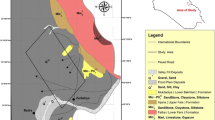Abstract.
When conducting environmental and engineering investigations in karst terranes, engineers and geologists often supplement exploratory borehole results with data gathered from surface geophysics to reduce the site-characterization cost and establish the most useful locations for borings or samples. When conducting resistivity investigations, a frequently occurring problem is the need to determine which of the many existing electrode configurations will respond best to the material changes in karst features. Each array has its advantages and disadvantages in terms of depth of investigation, sensitivity to horizontal or vertical variations, and signal strength. In the application presented in this paper, numerical forward modeling was conducted of dipole–dipole, Schlumberger, and Wenner arrays, and they produced markedly different anomaly shapes for a conceptual model of the development of a cover-collapse sinkhole. The resolution of the three above-mentioned arrays was further evaluated along a section of I-70 near Frederick, Maryland, where a sinkhole had occurred in the median of the highway. The image from the dipole–dipole array appeared to be better than those from the Wenner and Schlumerger arrays in displaying the sinkhole collapse area. However, they are all less effective than a mixed array, in which apparent resistivities from all the three arrays are combined and processed together in the model. Because the mixed array requires a significant increase in data collection, the dipole–dipole array appears to be the most effective and less costly configuration in mapping karst hazards areas. This conclusion was then confirmed by two case studies.
Similar content being viewed by others
Author information
Authors and Affiliations
Additional information
Electronic Publication
Rights and permissions
About this article
Cite this article
Zhou, W., Beck, B.F. & Adams, A.L. Effective electrode array in mapping karst hazards in electrical resistivity tomography. Env Geol 42, 922–928 (2002). https://doi.org/10.1007/s00254-002-0594-z
Received:
Accepted:
Issue Date:
DOI: https://doi.org/10.1007/s00254-002-0594-z




